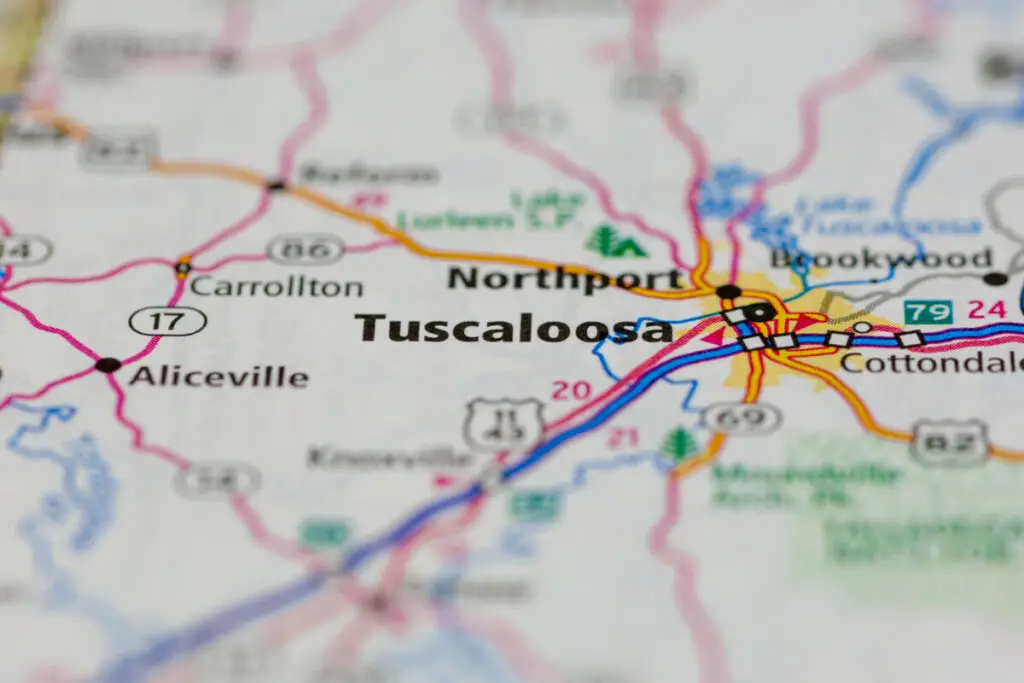
Although many States in the US are fairly open about their political standings, not all cities within them share the same values. For example, States in “the Bible Belt” are famously known to be in favor of the Republican party- but are all of their cities? Putting this question to the test; is Tuscaloosa, Alabama a conservative city?
Tuscaloosa, Alabama is reported to be a slightly Liberal-leaning city, though its county is consistently recorded as Republican. In the most recent presidential election, 56.7% of Tuscaloosa County voters voted red; 41.9% blue; and 1.4% Independent.
Even though its county and State of Alabama are much more Conservative-leaning than the US in general, Tuscaloosa City has more democratic voters than nearby cities. This article will be finding patterns and figuring out what makes it different than the rest of its surrounding areas.
The Importance of Demographics in Politics
Demographics allow for informed deductions to be made for why political climates reflect the results they do. Some of the most important demographics to look at in an analysis of political climate are the ones listed below, along with their value and importance:
Population: The number of people living in an area changes the entire realm of potential ratios within all other demographics of a city. Should a population be growing, it could be an indication that the city is becoming more diverse and has a higher chance of making political shifts. The population also affects how many potential voters a city has, the gender ratios, the ages of residents, and a number of other factors which can offset the polls.
Depending on the population or demographic type, a city will be much more likely to sway one way or another.
Race: When it comes to ethnic and racial origins, diversity is directly correlated with whether an area is more right or left-winged. Studies show that minority groups are more democratic leaning.
Education: Those with college degrees are much more likely to vote for the blue candidate.
Gender: There are more women in the United States than men. Historically, women have a greater voter turnout than men as the ratio of women to men has always been higher when it comes down to participation during elections. Men are more likely to be Conservative than a woman.
Age: Younger generations are consistent in their favorability toward the Democratic Party. Additionally, according to a study done in 2018, younger generations are more diverse than older ones within the United States where Millenials were reported to be more ethnically diverse and liberal than any adult generation. Anyone 38 years old or younger has a higher likelihood of being Democratic; this encompasses Gen X, Millennials, Gen Z, and Younger generations. The national average age is 38.1.
People born between 1928 and 1964; the Boomer and Silent generations are reliably Republican. Older, educated adults are more likely to be white and more likely to be religious. Both of these demographics within these age groups have a higher likelihood of being Conservative.
The Role of Religion in Politics

The Bible Belt: The Bible Belt is located in the South of the United States. It is known for its religious and conservative theological stances and values. It is consistent in its defense and continued voting for the Republican Party, and is therefore marked as a very red area on the US map. Alabama is located within this region.
Christian Beliefs: Christians, specifically Protestant Christians are almost always right-winged– encompassing Evangelicals and Baptists. These statistics indicate that cities that are predominately Christian have a greater likelihood of being more heavily populated by older generations This is because younger generations are proven to lean blue and are less prone to favor traditional views.
Religious Influence: Christian Republicans are more likely White than belonging to a minority group, indicating that prominently religious areas have greater chances of being less racially diverse, as minority groups are more likely to vote democratically.
Voter turnout is directly impacted by frequent church attendance. In addition, research has proven that religious values do influence the turnout of voters. Rising generations are becoming less religious and therefore less likely to be conservative.
Demographics in Tuscaloosa
Source 1:
Using data collected from the United States Census Beuro, as well as a report using data from the Census, demographics in Tuscaloosa City were reported to be as follows from 2020, when the most recent presidential election was held, as well as predictions made by the Beuro based on the data from previous years.
Average Age: 33.2
Population:
| The population of April 2020 | Population Estimate for April 2021 |
| 99,600 | 100,618 |
Ethnic or Racial Identity:
| Race | Percent |
| White Alone | 50.9% |
| Black or African American | 44.1% |
| Hispanic or Latino | 2.8% |
| Asian Alone | 2.5% |
| Two or More Races | 1.5% |
| American Indian and Alaskan Native Alone | 0.3% |
| Native Hawaiian and Other Pacific Islanders Alone | 0.0% |
Sex:
| Male | Female |
| 48.3% | 51.7% |
Education:
| Age Demographic | Degree | Percentage |
| 25 years or older | bachelor’s degree or higher | 38.3% |
Source 2:
With statistics gathered from proprietary data mapping and analysis, the University of Virginia, the US Census, and other resources, Source 2 reports Tuscaloosa City as having a Republican and Conservative history, although being more democratically friendly than surrounding areas.
Median Age in Tuscaloosa: 32.5 Years Old
Education:
| Degrees: | Percentage: |
| Bachelor’s or Higher | 36.37% |
Sex:
| Males: | Females: |
| 41.11% | 51.89% |
Self-Identified Race:
| Race | Percentage |
| White | 50.3% |
| Black | 42.5% |
| Hispanic | 3.5% |
| Asian | 2.4% |
| Other | 1.1% |
| Native American | 0.1% |
According to this study, the city is very diverse in regard to ethnic and racial constructs within the United States. Tuscaloosa was given a Diversity Score of 80 which is reportedly higher than most in the United States.
Tuscaloosa’s Religious Climate:
Like any location, the presence of religion has a great impact on a city and its outlook on morality. This affects whether a place leans liberally or is more right-winged as the values and principles are generally speaking more traditional or progressive depending on the demographical area and prevalence of specific religions in an area.
Shared in the following table is a statement of the religions being practiced in the city of Tuscaloosa and the presence of each:
| Religious Sect | Percentage of Religious Participants |
| Baptist | 33.4% |
| Another Christian faith | 7.6% |
| Methodist | 7.1% |
| Catholic | 2.0% |
| Pentecostal | 1.8% |
| Presbyterian | 1.5% |
| Episcopalian | 1.0% |
| Church of Jesus Christ | 0.7% |
| Islamic | 0.2% |
| Jewish | 0.1% |
| Lutheran | 0.1% |
| Of an Eastern Faith | 0.0% |
Source 3:
Source 3 is a detailed report of Tuscaloosa County Demographics from 2020. In order to understand the current state of Tuscaloosa’s political leniency, statistics from the collected data are shared below:
Population: 100,633
Overall Median Age: 29.5
| Race or Ethnic Identity | Percentage |
| White (Non-Hispanic) | 49.4% |
| Black (Non-Hispanic) | 43.9% |
| Hispanic | 2.8% |
| Asian (Non-Hispanic) | 2.47% |
| Multiracial (Non-Hispanic) | 1.1% |
Interpreting Tuscaloosa’s Political Climate
As of the current day, the City of Tuscaloosa is leaning slightly liberally. Since 2000, the county has voted for the Republican party. This is significant as the county of Tuscaloosa and the State of Alabama are notably Republican. This shift is recent, as, in the presidential election of 2020, the city was Conservative. Potential factors of this shift are noted below:
Significance of Tuscaloosa’s Population: There has been an increase in the population. This means all of the demographics within Tuscaloosa have had the opportunity to become more diverse and challenge traditional values. As the United States as a whole is numerically more Democratically leaning, with more people moving into the city, these new numbers may have tipped the polls just over the edge to be blue-favoring.
Diversity in Tuscaloosa: Simply put, with a high diversity score of 80, data would suggest Tuscaloosa votes Democratically. However, those coming of White descent are still in the majority of the population, which could explain the recent and most prevalent consistency of conservative favorability.
Gender Ratios in Tuscaloosa: There are more women than men in Tuscaloosa. This being said, educated women are more likely to vote democratically, and those with college degrees are in minority at large.
Education in Tuscaloosa: Tuscaloosa is only slightly in its favoritism towards being blue leaning. The city has only recently shifted its stance and is still heavily influenced by its Republican values. The population of adults with higher education is in a significant minority. As studies have shown, this stipulates favorability in leaning red.
Religious Influence within Tuscaloosa: As the city is highly populated by practicing Protestant Christians, it makes sense that the ratio of liberal to conservative voters is so close. Religious participants are in a slight majority. This could mean that Tuscaloosa’s political climate could swing back to red fairly easily, as statistics are in favor of a more Conservative belief system.
Final Remarks
A shift back over to red is not an illogical speculation, considering how recent Tuscula’s changeover has been reported, as well as how close to the center of the spectrum its leniency is.

